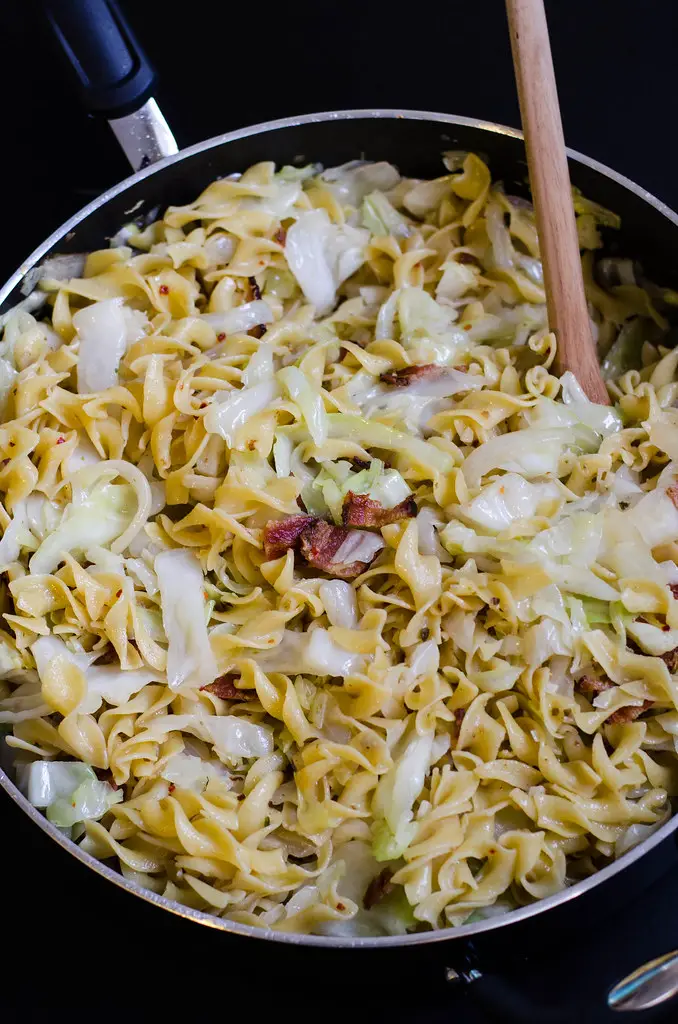Haluski Soup Recipe: A Delicious and Easy-to-Make Comfort Food
If you’re looking for a hearty and comforting soup to warm you up on a chilly day, look no further than haluski soup. This traditional Eastern European dish features tender egg noodles, savory cabbage, and crispy bacon, all simmered together in a rich and flavorful broth. Whether you’re craving a bowl of soup to cozy up with on a cold winter evening or you’re simply looking for a new recipe to add to your collection, haluski soup is sure to satisfy.
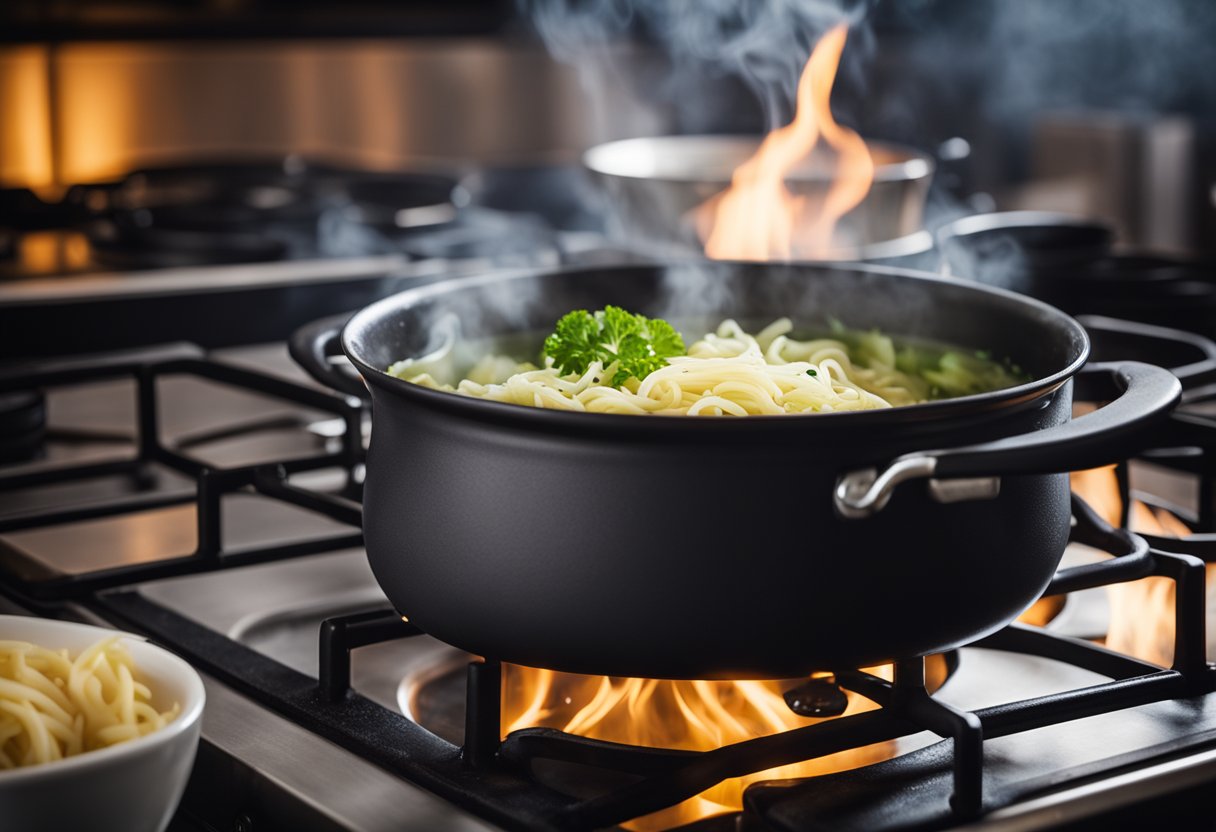
Origin and History: Haluski soup has its roots in Eastern European cuisine, particularly in Poland and Ukraine. The dish is typically made with simple, affordable ingredients that were readily available to farmers and peasants in the region. Over time, haluski soup has become a beloved comfort food for many people, both in Eastern Europe and around the world. While there are many variations of the recipe, the basic ingredients and cooking process remain the same.
Key Takeaways
- Haluski soup is a traditional Eastern European dish featuring egg noodles, cabbage, and bacon in a flavorful broth.
- The dish has its roots in peasant cuisine and is known for its simplicity and affordability.
- Haluski soup is a comforting and satisfying meal that is perfect for a chilly day or a cozy night in.
Origin and History of Haluski Soup
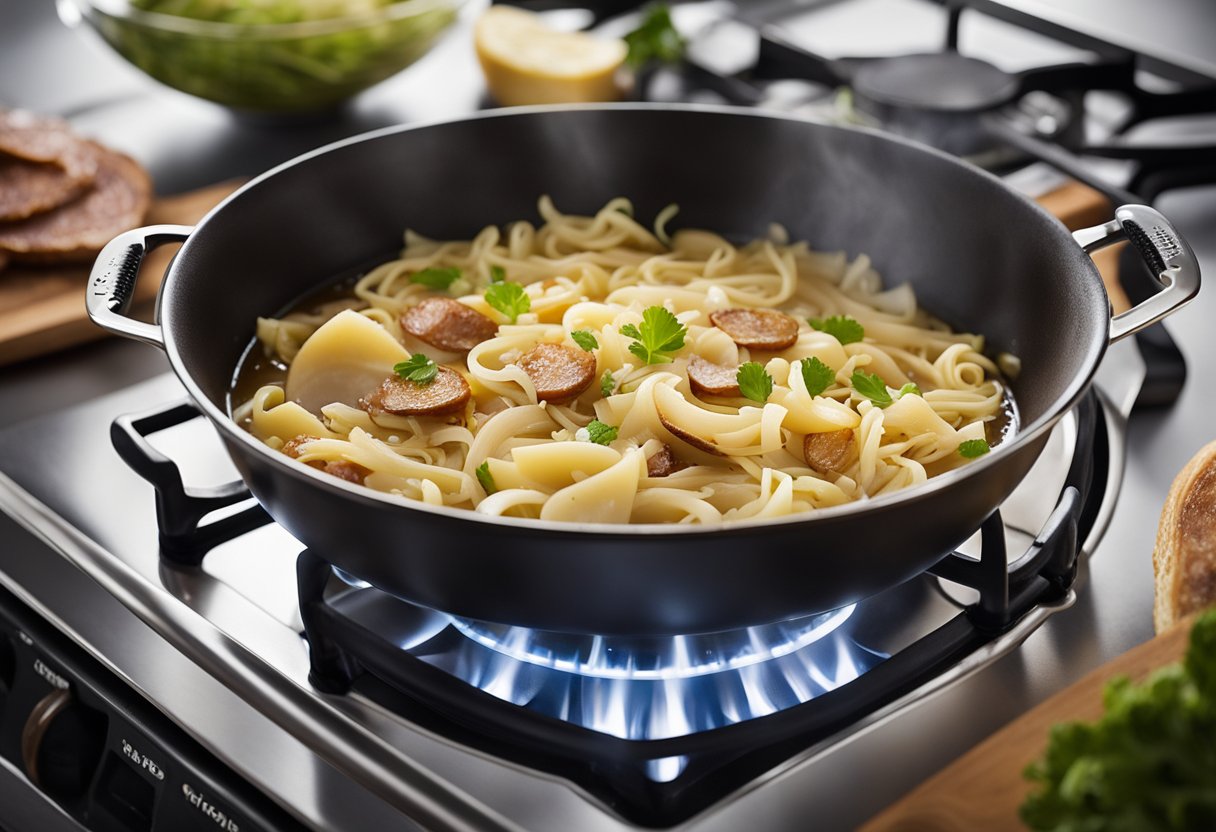
Haluski soup is a traditional dish that originated in Central and Eastern Europe. The dish is primarily associated with Polish and Slovak cuisine, but variations of it are also found in other countries such as Ukraine, Hungary, and the Czech Republic.
The name “haluski” comes from the Slovak word “halusky,” which means small dumplings. The soup is made by combining these small dumplings with sautéed cabbage and onions, and then simmering them in a broth made from chicken or vegetable stock.
The dish has a long history and is often associated with peasant cuisine. It was a popular dish among farmers and laborers because it was hearty and filling, and used simple, inexpensive ingredients that were readily available. Over time, the dish has become a staple of many families and is often served at family gatherings and holiday celebrations.
Today, there are many variations of haluski soup, each with its own unique twist on the classic recipe. Some recipes call for the addition of bacon or sausage, while others use different types of dumplings or vegetables. Despite these variations, the dish remains a beloved comfort food that is enjoyed by many people around the world.
Essential Ingredients for Haluski Soup
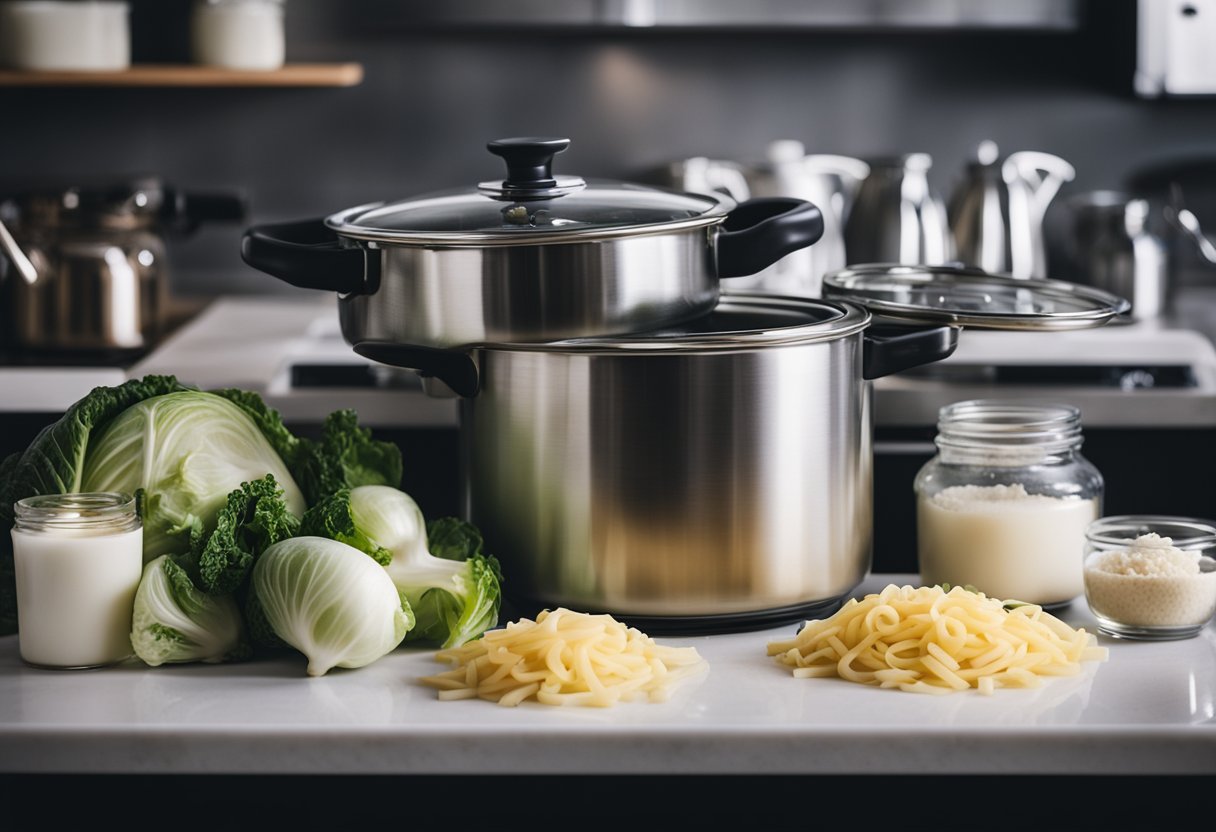
When it comes to making a delicious Haluski soup, there are a few essential ingredients that you simply cannot do without. These ingredients are what give the soup its unique flavor and texture, and they are what make it so satisfying to eat. In this section, we’ll take a closer look at each of these ingredients and explain why they are so important.
Cabbage
Cabbage is the star ingredient in Haluski soup, and it’s what gives the soup its distinctive flavor and texture. When choosing cabbage for your soup, look for fresh, firm heads that are free from blemishes and bruises. You’ll need to slice the cabbage thinly, so make sure to remove the tough core before you start.
Noodles
Noodles are another essential ingredient in Haluski soup, and they provide a hearty base for the soup. You can use any type of noodle you like, but we recommend using egg noodles for the best results. These noodles are soft and tender, and they absorb the flavors of the soup beautifully.
Onions
Onions are a key ingredient in many soups, and Haluski soup is no exception. They add a sweet, savory flavor to the soup, and they help to balance out the richness of the cabbage and noodles. When cooking with onions, make sure to chop them finely so that they cook evenly.
Garlic
Garlic is another important ingredient in Haluski soup, and it adds a pungent, aromatic flavor to the soup. When using garlic, make sure to chop it finely and sauté it gently before adding it to the soup. This will help to release its full flavor and aroma.
Overall, these four ingredients are the foundation of any great Haluski soup recipe. By using fresh, high-quality ingredients and cooking them with care, you can create a soup that is both delicious and satisfying.
Kitchen Tools Needed for Haluski Soup

To make a delicious haluski soup, you will need a few essential kitchen tools. Here are the items you will need:
1. Large Soup Pot
A large soup pot is essential for making haluski soup. It should be big enough to hold all the ingredients and allow room for stirring. A pot with a lid is also recommended to help keep the heat in and prevent any splatters.
2. Cutting Board and Knife
You will need a cutting board and a sharp knife to chop the vegetables and cabbage for the soup. A good quality knife will make the job easier and safer.
3. Wooden Spoon
A wooden spoon is perfect for stirring the soup and scraping any bits from the bottom of the pot. It is also gentle on the pot’s surface and won’t scratch it.
4. Measuring Cups and Spoons
To ensure you add the right amount of ingredients, you will need measuring cups and spoons. This is especially important for the flour and butter used to make the roux.
5. Ladle
A ladle is necessary for serving the soup. It makes it easy to portion out the soup into bowls without making a mess.
6. Bowls and Spoons
Finally, you will need bowls and spoons to serve the soup. Make sure they are large enough to hold a generous serving of soup and comfortable to hold.
By having these essential kitchen tools on hand, you will be well-equipped to make a delicious haluski soup.
Preparing the Ingredients
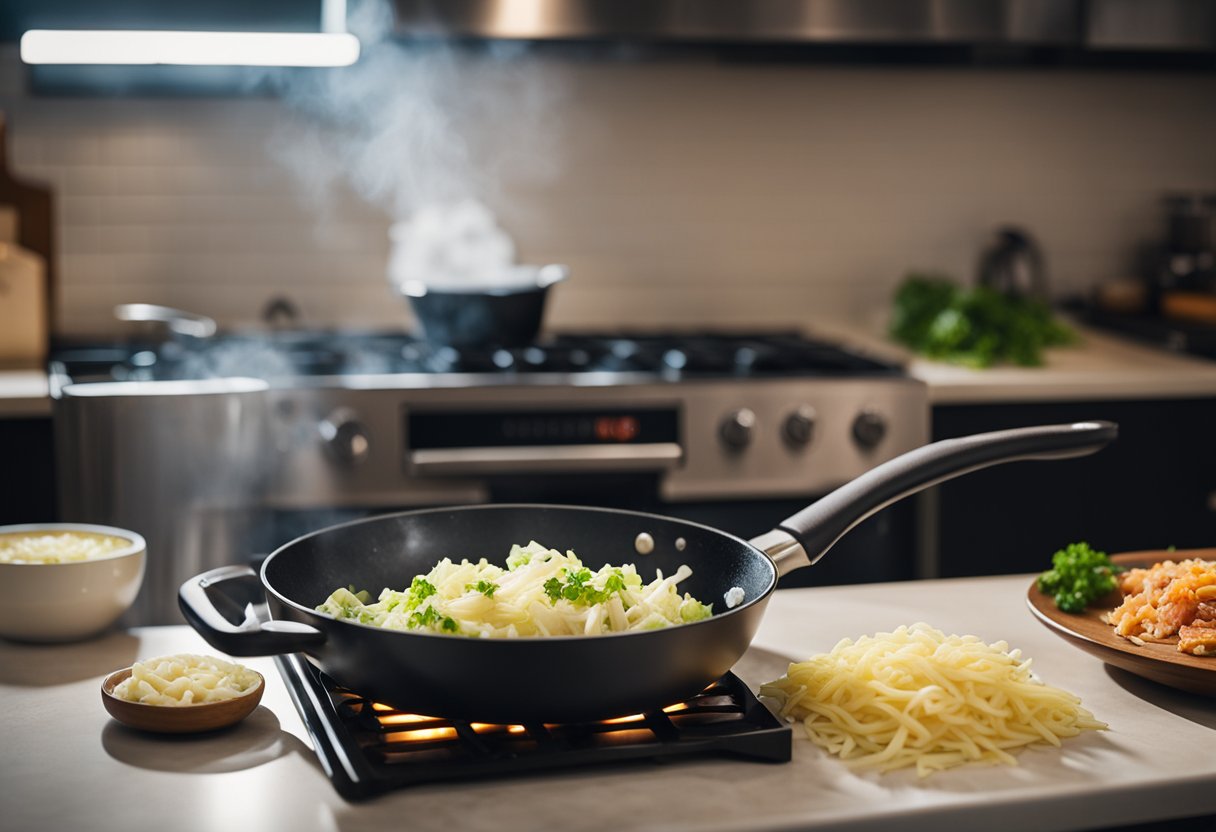
To make a delicious haluski soup, you’ll need to start with fresh and high-quality ingredients. Here’s what you’ll need to prepare:
Cabbage
Choose a fresh head of cabbage that is firm and heavy for its size. Remove the outer leaves and rinse the cabbage under cold water. Cut the cabbage in half and remove the core. Slice the cabbage into thin strips and set it aside.
Onion
Peel and chop a large onion. You can use yellow or white onions for this recipe.
Garlic
Peel and mince 3-4 cloves of garlic. Fresh garlic will give your soup a delicious aroma and flavor.
Bacon
Cut 4-5 slices of bacon into small pieces. Bacon adds a rich and savory flavor to the soup.
Noodles
Use egg noodles for this recipe. You can use either wide or medium egg noodles. Cook the noodles according to the package instructions and set them aside.
Butter
Melt 2-3 tablespoons of butter in a large pot over medium heat.
Salt and Pepper
Season the soup with salt and pepper to taste.
By preparing these ingredients beforehand, you’ll be able to make a delicious and flavorful haluski soup in no time.
Cooking Process
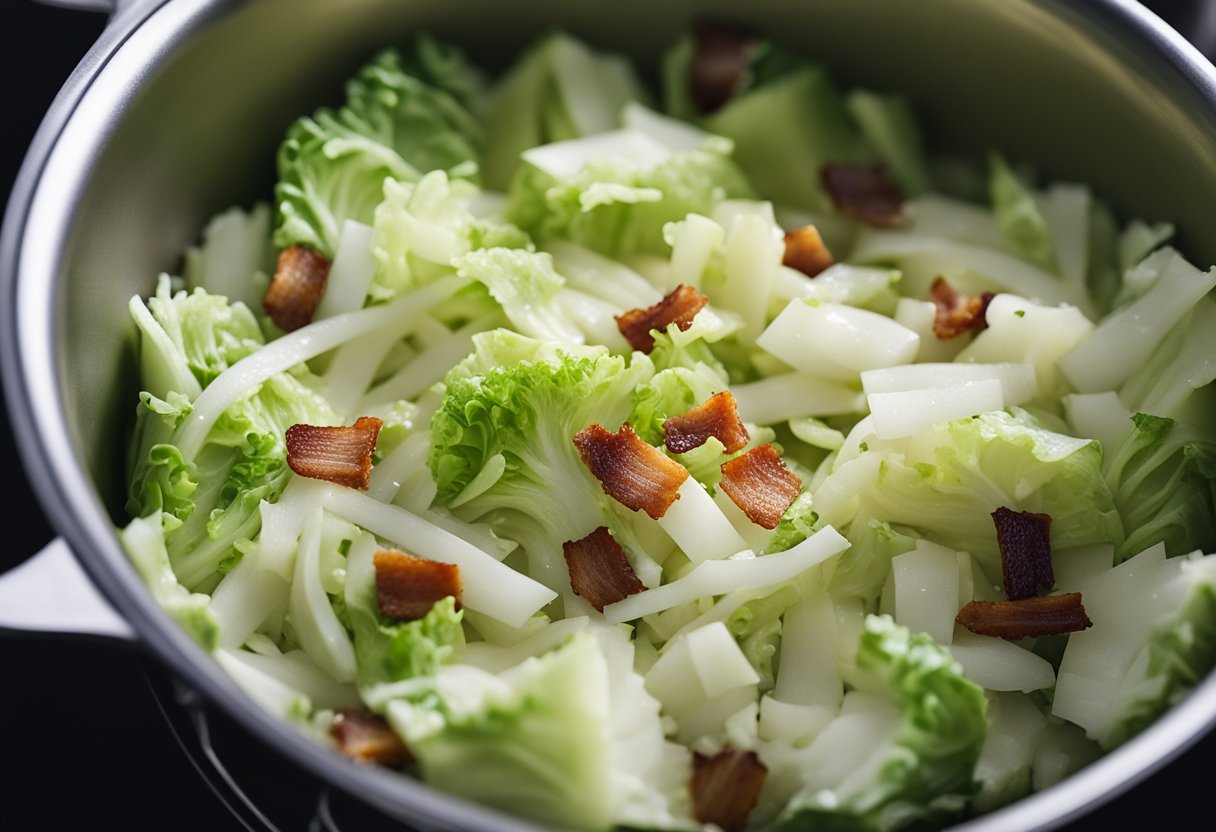
Sautéing Vegetables
To start making haluski soup, you will need to sauté your vegetables. Begin by heating a large pot over medium heat and adding a tablespoon of oil. Once the oil is hot, add chopped onions and garlic to the pot and sauté for 2-3 minutes until the onions are translucent. Then, add sliced cabbage and continue to sauté for an additional 5-7 minutes until the cabbage is tender and slightly browned.
Boiling Noodles
While your vegetables are cooking, you can start boiling your noodles. Bring a separate pot of salted water to a boil and add your egg noodles. Cook for 8-10 minutes until the noodles are tender but still slightly firm. Drain the noodles and set them aside.
Combining Components
Once your vegetables and noodles are cooked, it’s time to combine them. Add the cooked noodles to the pot with the sautéed vegetables and stir to combine. Then, pour in chicken broth and bring the soup to a simmer. Let the soup simmer for 5-10 minutes to allow the flavors to meld together.
For added flavor, you can also add some cooked bacon or kielbasa to the soup. Serve hot and enjoy your delicious bowl of haluski soup.
Serving Suggestions for Haluski Soup
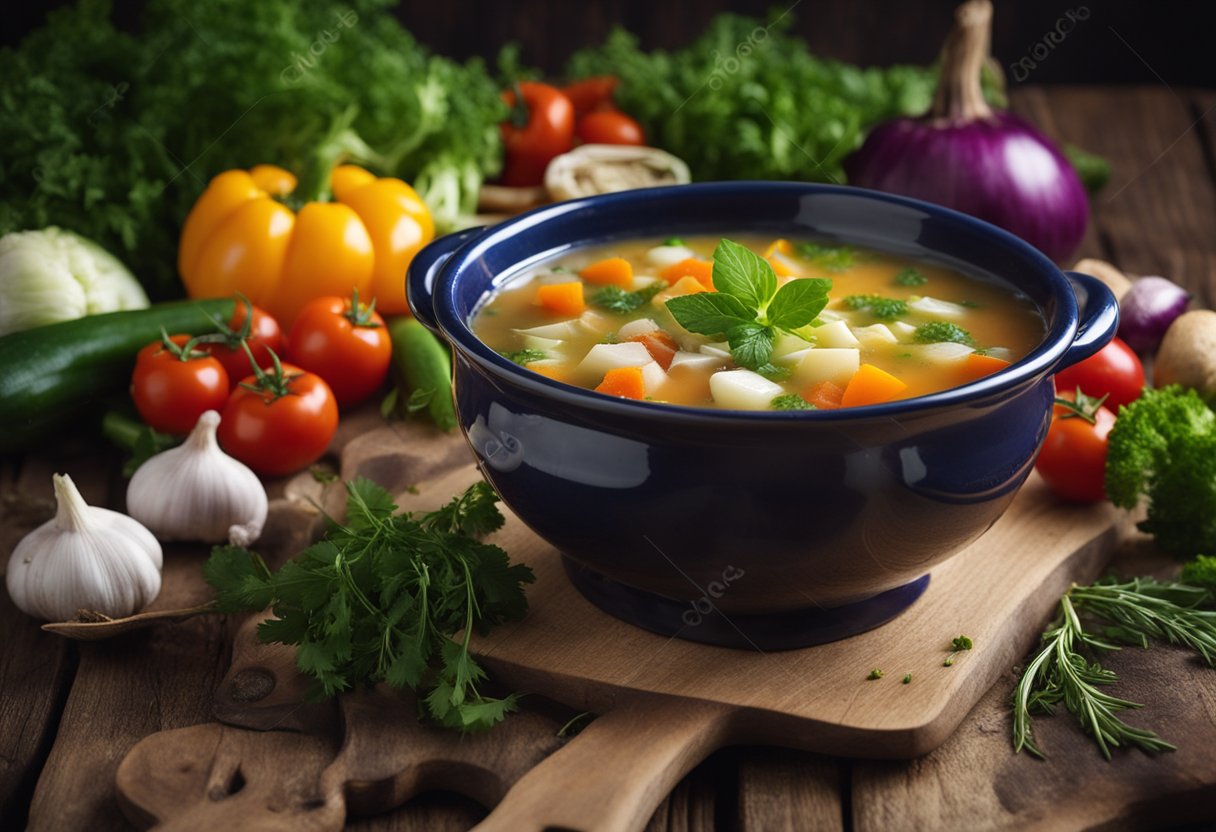
Now that you have made a delicious pot of haluski soup, it’s time to think about how to serve it. Here are a few suggestions to elevate your dining experience:
- Bread: Serve the soup with a warm, crusty bread to soak up all the delicious broth. A loaf of fresh-baked bread or a baguette would be perfect.
- Herbs: Add a sprinkle of fresh herbs on top of the soup for a pop of color and flavor. Chopped parsley, dill, or thyme would work well.
- Sour cream: A dollop of sour cream on top of the soup adds a creamy texture and tangy flavor. It’s especially delicious with the cabbage and noodles.
- Croutons: Make your own croutons by toasting cubes of bread in the oven with a little olive oil and salt. Sprinkle them on top of the soup for a satisfying crunch.
- Cheese: Grate some Parmesan or cheddar cheese on top of the soup for a cheesy twist. The saltiness of the cheese pairs well with the savory broth.
These serving suggestions are just a starting point. Feel free to get creative and experiment with your own toppings and garnishes. With a bowl of warm and comforting haluski soup, the possibilities are endless. Enjoy!
Variations and Substitutions
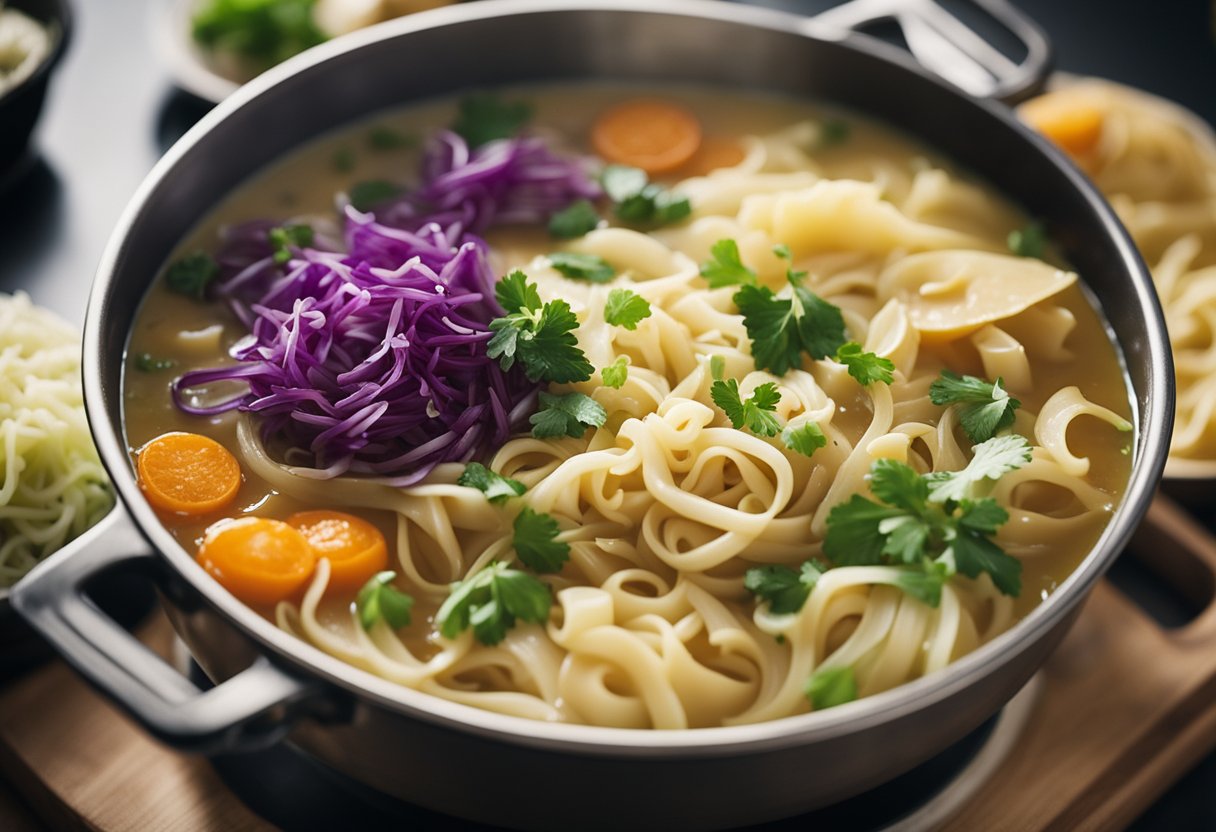
There are many ways to modify the traditional haluski soup recipe to suit your tastes or dietary needs. Here are some suggestions:
- Vegetarian option: Instead of using bacon or ham, you can add mushrooms or tofu to the soup for a meat-free version.
- Gluten-free option: Use gluten-free pasta or rice instead of egg noodles to make the soup gluten-free.
- Low-carb option: Replace the egg noodles with zucchini noodles or spaghetti squash to make a low-carb version of the soup.
- Spice it up: Add red pepper flakes, cayenne pepper, or hot sauce to give the soup a little kick.
- Add more veggies: You can add other vegetables to the soup, such as carrots, celery, or bell peppers, to increase the nutritional value and add more flavor.
- Change up the cheese: Instead of using cheddar cheese, you can use Parmesan, Swiss, or another type of cheese to give the soup a different flavor.
Remember, these are just suggestions, and you can always experiment with different ingredients to make the soup your own.
Storage and Reheating
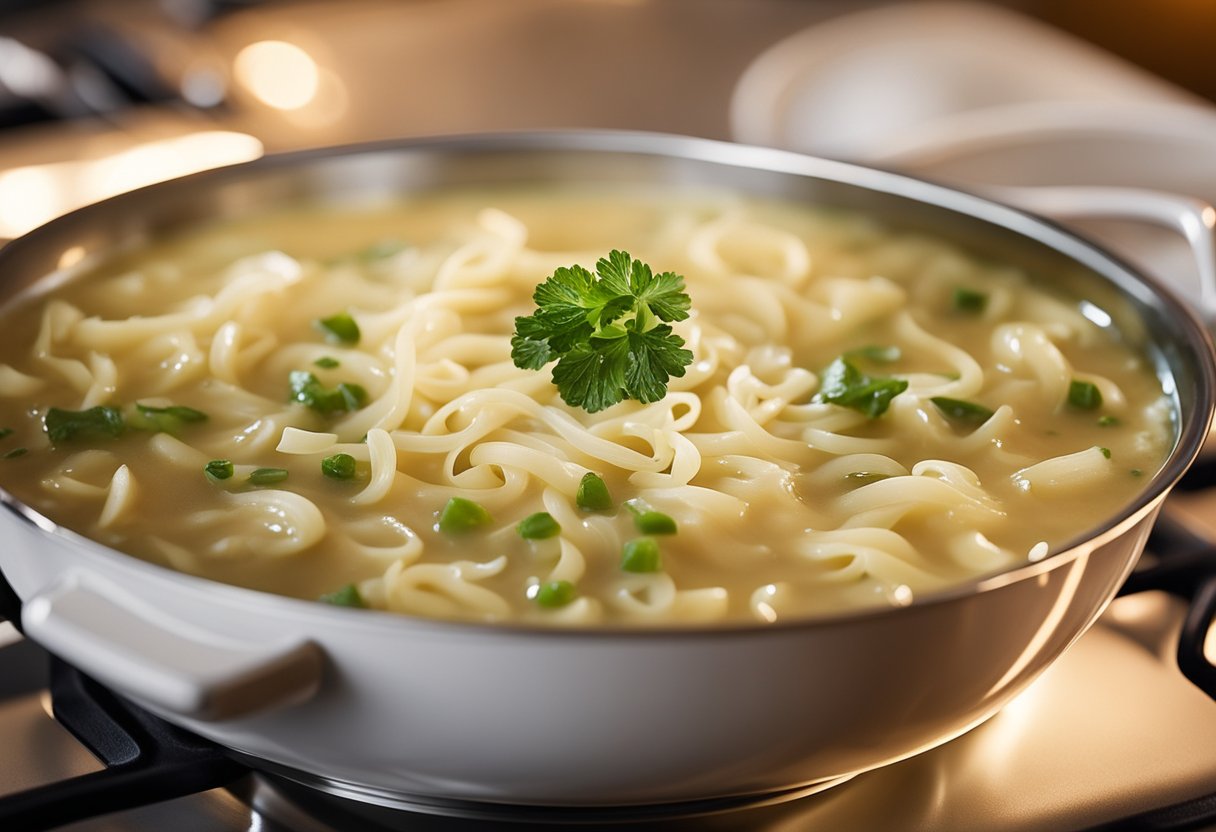
Once you have made your delicious Haluski soup, it’s important to store and reheat it properly to ensure that it stays fresh and retains its taste. Here are some tips to help you store and reheat your soup:
Storage
- Allow the soup to cool down to room temperature before storing it.
- Store the soup in an airtight container in the refrigerator for up to 3-4 days.
- If you want to store the soup for a longer period, you can freeze it for up to 3 months. Make sure to use a freezer-safe container and leave some space at the top to allow for expansion.
- Label the container with the date and contents to keep track of when it was made and what it contains.
Reheating
- To reheat the soup, transfer it to a pot and heat it on medium heat until it reaches the desired temperature. Make sure to stir occasionally to prevent it from burning.
- You can also reheat the soup in the microwave. Transfer it to a microwave-safe bowl and heat it in 30-second intervals, stirring in between, until it’s heated through.
- If the soup is too thick, you can add some water or broth to thin it out to your desired consistency.
- Do not reheat the soup more than once as it can promote the growth of harmful bacteria.
By following these simple tips, you can ensure that your Haluski soup stays fresh and delicious even after it’s been stored and reheated.
Nutritional Information
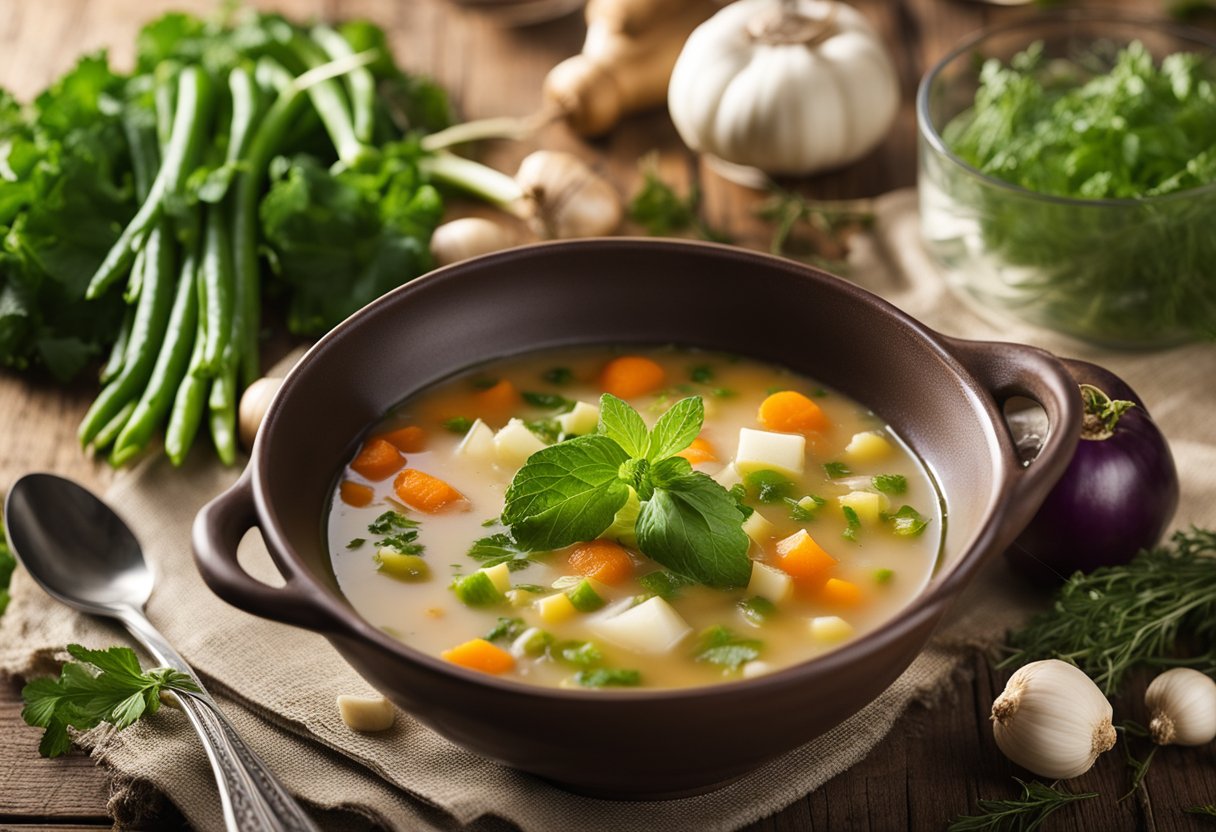
When it comes to the nutritional value of the Haluski soup, it is essential to take a closer look at its ingredients. The soup is primarily made of cabbage, onions, noodles, and a few other ingredients, making it a relatively healthy meal option.
One serving of Haluski soup (1 cup) contains approximately 150-200 calories, depending on the recipe’s specific ingredients. It also contains essential vitamins and minerals, such as Vitamin C, Vitamin K, and Vitamin B6, which are all crucial for maintaining good health.
The soup is relatively low in fat, with most recipes containing less than 5 grams of fat per serving. It is also a good source of dietary fiber, with one serving providing around 3-4 grams of fiber.
However, it is worth noting that some Haluski soup recipes may contain high amounts of sodium, which can be harmful to individuals with high blood pressure. It is essential to check the recipe’s sodium content before preparing it and adjust the seasoning accordingly.
Overall, Haluski soup can be a healthy and satisfying meal option, provided that you choose the right ingredients and prepare it in a healthy way.
Frequently Asked Questions
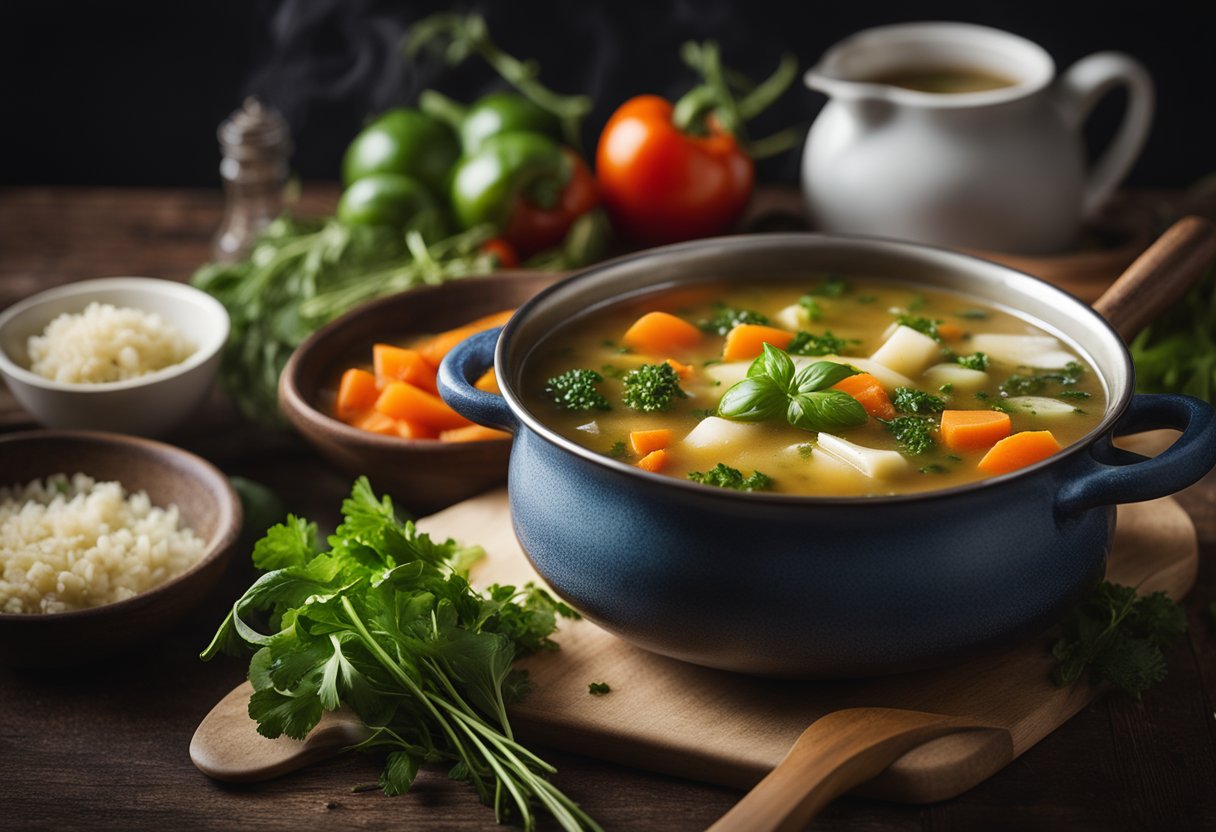
What are the essential ingredients for a traditional haluski soup?
To make a traditional haluski soup, you will need cabbage, onions, butter, egg noodles, and chicken broth. Some recipes may also include bacon or kielbasa for added flavor.
How can I make a simple and quick haluski soup at home?
For a quick and easy haluski soup, you can use pre-shredded cabbage and store-bought egg noodles. Sauté the cabbage and onions in butter, then add chicken broth and noodles. Simmer until the noodles are cooked through, and enjoy!
What is the secret to making the best-tasting haluski soup?
The secret to making the best-tasting haluski soup is to cook the cabbage and onions until they are soft and caramelized. This will bring out their natural sweetness and enhance the flavor of the soup. Additionally, using homemade chicken broth and fresh egg noodles can take the soup to the next level.
Can you provide steps for an authentic haluski soup recipe?
Sure! Here are the steps for an authentic haluski soup recipe:
- In a large pot, melt butter over medium heat.
- Add chopped onions and sauté until translucent.
- Add shredded cabbage and continue to sauté until soft and caramelized.
- Pour in chicken broth and bring to a boil.
- Add egg noodles and simmer until cooked through.
- Serve hot with a sprinkle of black pepper.
How can I store haluski soup and how long will it stay fresh?
To store haluski soup, let it cool to room temperature and transfer it to an airtight container. You can store it in the refrigerator for up to 3 days or in the freezer for up to 3 months. When reheating, add a splash of water or chicken broth to thin out the soup as needed.
What are the variations in haluski soup recipes across different regions?
Haluski soup is a popular dish in many Eastern European countries, and each region has its own variation. Some recipes may use sauerkraut instead of cabbage, while others may add potatoes or carrots. Some versions may also use sour cream or vinegar to add tanginess to the soup.
More you’ll love
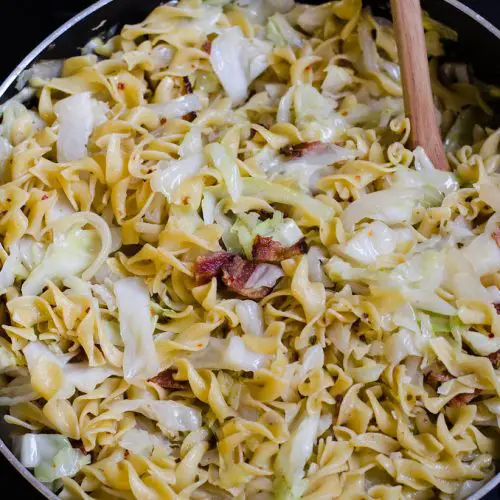
haluski soup
Equipment
- arge soup pot or Dutch oven Used for cooking the soup and accommodating all the ingredients.
- Cutting board For chopping vegetables and other ingredients.
- Chef's knife For slicing and chopping ingredients.
- Wooden spoon or spatula For stirring the soup while it cooks.
- Measuring cups and spoons For accurately measuring ingredients.Ladle: For serving the soup.
- Pot for boiling noodles or pasta if cooking noodles or pasta separately from the soup.
- Colander For draining cooked noodles or pasta
- Soup bowls For serving the finished haluski soup.
- Optional Skillet or frying pan: If you're cooking sausage or bacon to add to the soup
Ingredients
- 1 tablespoon olive oil or butter
- 1 onion finely chopped
- 2 cloves garlic minced
- 4 cups shredded cabbage about 1 small head
- 6 cups chicken or vegetable broth
- 2 carrots peeled and diced
- 2 celery stalks diced
- 1 bay leaf
- 1 teaspoon dried thyme
- Salt and pepper to taste
- 1 cup egg noodles or pasta of your choice
- Optional: cooked sausage or bacon sliced (for meat variation)
- Fresh parsley chopped (for garnish)
Instructions
- Heat the olive oil or butter in a large soup pot over medium heat. Add the chopped onion and garlic, and sauté until they are softened and fragrant, about 3-5 minutes.
- Stir in the shredded cabbage, carrots, and celery. Cook, stirring occasionally, until the vegetables begin to soften, about 5-7 minutes.
- Pour in the chicken or vegetable broth, and add the bay leaf, dried thyme, salt, and pepper. Bring the soup to a simmer, then reduce the heat to low and let it cook, partially covered, for about 20-25 minutes, or until the vegetables are tender.
- If you're adding cooked sausage or bacon, stir it into the soup at this point.
- While the soup is simmering, cook the egg noodles or pasta according to the package instructions until al dente. Drain and set aside.
- Once the vegetables are tender, remove the bay leaf from the soup. Taste and adjust the seasoning if needed.
- To serve, ladle the soup into bowls and add a portion of cooked noodles or pasta to each bowl. Garnish with chopped fresh parsley, if desired.
- Serve hot and enjoy your comforting bowl of haluski soup!
Notes
- Variations: Haluski soup can be customized in various ways. You can add different vegetables such as potatoes, bell peppers, or green beans. If you prefer a meatier soup, consider adding cooked sausage, bacon, or even shredded chicken.
- Broth: Use chicken or vegetable broth as the base for the soup. You can use store-bought broth or homemade broth for the best flavor. If using store-bought broth, opt for low-sodium varieties to control the saltiness of the soup.
- Cabbage: Shredded cabbage is a key ingredient in haluski soup. You can use green cabbage or savoy cabbage, whichever you prefer. Make sure to shred the cabbage finely for quicker cooking and better texture in the soup.
- Noodles: Traditional haluski soup often uses egg noodles, but you can use any type of pasta you like. Wide egg noodles work well, but you can also use small pasta shapes like shells or elbows. Cook the noodles separately and add them to the soup just before serving to prevent them from becoming mushy.
- Seasoning: Adjust the seasoning of the soup according to your taste. You can add additional herbs and spices such as paprika, parsley, or dill for extra flavor. Taste the soup before serving and add more salt and pepper if needed.
- Storage: Haluski soup can be stored in an airtight container in the refrigerator for up to 3-4 days. Reheat the soup gently on the stovetop or in the microwave until heated through before serving.
- Garnish: Fresh chopped parsley is a classic garnish for haluski soup, but you can also use other herbs like chives or green onions. A dollop of sour cream or a sprinkle of grated cheese can also be added as a finishing touch.
- Make it Vegetarian or Vegan: To make the soup vegetarian or vegan, simply use vegetable broth and omit any meat or meat-based ingredients. You can also add tofu or tempeh for protein if desired.

